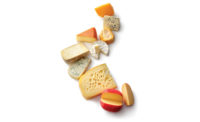The dairy industry has been facing a variety of challenges this year — most notably, the COVID-19 pandemic. Dairy Foods asked the top executives of leading dairy associations to discuss the industry’s more significant issues, as well as its greatest opportunities.
Participants include Blake Anderson, CEO of the American Dairy Products Institute (ADPI); Michael Dykes, D.V.M., president and CEO of the International Dairy Foods Association (IDFA); Brad Legreid, executive director of the Wisconsin Dairy Products Association (WDPA); John Umhoefer, executive director of the Wisconsin Cheese Makers Association (WCMA); and Tom Vilsack, president and CEO of the U.S. Dairy Export Council (USDEC).
Dairy Foods: 2020 has been quite a year, bringing with it a worldwide pandemic, social unrest and other challenges. Heading into 2021, what are your members most worried about, and why?
 Blake Anderson: The health and safety of employees and their families would be the No. 1 concern without question, followed by the continued disruption to their businesses, and what longer-term impacts will need to be mitigated in whatever the “new normal” will be. This is not just related to the pandemic, but is inclusive of geo-political and societal issues impacting domestic and international trade and commerce.
Blake Anderson: The health and safety of employees and their families would be the No. 1 concern without question, followed by the continued disruption to their businesses, and what longer-term impacts will need to be mitigated in whatever the “new normal” will be. This is not just related to the pandemic, but is inclusive of geo-political and societal issues impacting domestic and international trade and commerce.

Michael Dykes: The myriad challenges posed to the dairy industry in 2020 has made our industry stronger, nimbler and more attune to risk. Even in a post-COVID world, we’re going to continue to see a lot of volatility, ambiguity and disruption. While this obviously isn’t our goal, it strengthens our industry and presents opportunities in the midst of such uncertainty.
For one, we expect technology to continue to accelerate disruptions to our business. Think about the rapid shift to online retail. Curbside pickup and at-home delivery have grown 12% during the pandemic. Retail giants have introduced checkout-free technology in some of their stores. More processors with a nationwide or global reach have introduced virtual and multimedia product showcases to meet customers where they reside.
We also expect political risk to continue to grow, regardless of the political outcomes of the presidential elections. Politicians are taking more political actions that significantly affect business at all levels of government. This was not new in 2020 and won’t be new in 2021, but it is increasingly challenging for businesses to plan for and mitigate the business risk.
Finally, deglobalization is increasing, and that’s a threat to our industry’s growth. The U.S. government’s talk about “decoupling” with the Chinese economy is one example. With the USDA forecasting an additional 15% of milk output from U.S. farms by 2028, we must, as an industry, stay on the offense and ensure we open new markets for dairy across the world.

Brad Legreid: Following a year like 2020, no one really knows what to expect in 2021. Will COVID-19 persist and continue casting a dark cloud of pessimism and uncertainty over the country? Who will be the next U.S. president and how will Wall Street react to this leader? Will workers want to return to their offices rather than working from home, and will furloughed employees get their jobs back? Can the country regain the robustness it had prior to the onslaught of COVID?
These are significant questions, since any one of them can have a powerful impact on our economy. For instance, if students don’t return to school next year, the school milk program will greatly suffer. If the economy starts languishing and people don’t have secure employment, they will continue tightening their belts and cutting back on their spending habits. This could potentially help staple food items, like milk, cheese and butter.
With this expansive backdrop of uncertainty hanging over our county, dairy processors continue to face ongoing stressors, such as will there be a sufficient workforce to fill dairy manufacturing jobs? If COVID leads to a sharp increase in laid-off workers in other business sectors, there may be a greater availability of workers. However, if the economy regains its vigor in 2021, unemployment rates will fall and tighten up the job market. Also, will immigration policies offer a portal for obtaining needed employees?
Besides employment concerns, dairy plants will be impacted by any changes to current U.S. trade agreements. It’s generally accepted that the USMCA agreement will benefit the U.S. dairy industry. However, if there is a different president next year, will this trade agreement be altered? Also, will the trade agreement with China be modified? Any changes could have significant ramifications for the dairy industry.

John Umhoefer: It has been a year unlike any other. Now that the industry is past the initial shock wave of the economic impact of this pandemic, concerns have turned to managing the volatility in milk prices, cheese prices and product held in inventory. Other issues such as challenges with supply chains for packaging materials and ingredients, product trucking and lost buyers have diminished. Labor remains a concern, both finding quality candidates for a range of jobs in processing, and keeping our teams safe and healthy and working as COVID-19 rates spike in the Upper Midwest.
Commodity markets — certainly cheddar — have fallen and risen with unprecedented speed and magnitude, challenging milk pricing decisions, pooling decisions, cheese production schedules and inventory control. Sales through to retail channels have been reliable, but foodservice recovery remains the question mark. Our member manufacturers worked with amazing speed to reconfigure their product mix, find sales in new market channels and even staff up to build sales in international markets this year.

Tom Vilsack: Even if daily life returns to something approaching normal in 2021, COVID-19 will have a lingering impact on the global economy, including dairy markets.
Mexico, our No. 1 dairy export market, is on our watch list. The country's economy was already precarious before COVID-19 thanks to a deceleration in manufacturing, a reduction in investment and an uncertain policy environment.
Combine those factors with an oil price collapse, a weakened peso and insufficient government stimulus, and you have the potential of a prolonged recession in a country that purchased more than $1.5 billion in U.S. dairy exports last year.
To mitigate the risk of being too dependent on a single nation’s economy, many of our members are diversifying to new markets, including the Middle East/North Africa, South America and Southeast Asia. That’s a wise strategy. Our exports to Mexico have decreased this year, but we have more than made up for that with booming sales of ingredients to Southeast Asia.
Dairy Foods: How is your association helping its members better weather these trying times?
Anderson: We are exemplifying our core values in everything we do. Being responsive to member needs, providing reliable and useful information, being relevant in our work with unwavering focus on our mission and goals, being respectful of others and working collaboratively, and building relationships that create opportunities for them to be successful.
Dykes: IDFA leaders from across each of our five Segment Boards — Cheese, Fluid Milk, Ice Cream, Ingredients, and Yogurt and Cultured Products — have been meeting throughout the summer on our Vision for the Future, a plan that positions IDFA to lead on the new, emerging and strategic issues that will drive our industry over the next five to 10 years.
Throughout these conversations, it has become abundantly clear that many forces outside of our traditional realm of influence — issues like public health, consumer preferences and political risks — are now front and center for our industry. At the same time, our focus on global competitiveness, sustainability, innovation and technology, and attracting the workforce of the future have never been more important to the success of the industry.
Today’s dairy business leaders want to continue to lead our evolving industry through these challenges to ensure a prosperous future for dairy. That’s the focus of IDFA right now — to position our industry to evolve, to attract diverse talent, to mitigate the impact of extraneous factors and to continue to deliver the nutritious, wholesome and delicious products that consumers across the world have come to expect from the dairy industry.
Legreid: Once COVID-19 fully surfaced in March, the goal of WDPA was to establish itself as a primary information provider for our member companies. In the early days of the pandemic, dairy companies were staring into a black hole of uncertainty, filled with new and unexpected challenges. Supply chains were being disrupted, excess milk was being disposed and new sanitary and hygienic guidelines were mandated. There was an overabundance of questions, but a paucity of answers.
Every day, WDPA obtained relevant and necessary information from federal and state regulatory agencies, as well as from our Congressional offices. Our association served as a conduit between these agencies and our members, disseminating every new update and development. In addition, WDPA responded to myriad questions from our members pertaining to ever-changing state-mandated regulations encompassing food manufacturing plants. WDPA also worked with our members to facilitate product donations to local food banks in need of supplies during the pandemic.
More recently, WDPA organized two separate special events for our members. One of the unfortunate consequences of COVID are the cancellations of almost all dairy-related meetings and events in 2020. Being fully cognizant of how much the dairy industry thrives on personal interactions, WDPA proceeded to sponsor two well-attended events which afforded our members much-needed opportunities to socialize with their dairy peers. Local health guidelines were observed to ensure our members’ wellbeing. The attendees were extremely appreciative of the opportunities to see old friends and experience — for a few hours — a bit of normalcy once again.
Umhoefer: For at least four months this spring and into summer, WCMA focused nonstop attention on a flood of member concerns related to the economic hit from the pandemic. Our membership-wide communication scaled up to daily bulletins early on, but even more crucial was nonstop personal communication with member companies. In the initial weeks, members faced emergency needs for unsold product, excess milk, cold storage, packaging supplies, contacts in new market channels and an understanding of the federal financial aids offered to businesses. WCMA continues to report on regulatory and economic issues related to the pandemic in newsletters to members twice each week.
Like many other organizations, WCMA has turned to concise, free webinars to reach members, and we have focused on nut-and-bolts issues such as county-level health department response to positive COVID-19 cases in plants and shared strategies for social distancing and staffing. WCMA partnered with Dairy Farmers of Wisconsin and Center for Dairy Research (as the Dairy Food Safety Alliance) to quickly develop SOPs for dairy plants regarding worker safety and action steps for workers testing positive.
This economic upheaval has forged a new area for partnership as well: Our Association has connected members with food banks and food pantries, and state officials and USDA staff involved in food purchase and distribution through multiple feeding programs. These new connections in product donation and procurement specs and our efforts to help members navigate the paperwork of these worthy public and private efforts comprise a “new wing” in our organization that is here to stay.
So there is a bright side to all this volatility. WCMA has helped members form new connections between one another, and our staff has made connections deeper into departments and teams at our members’ organizations.
Vilsack: Our staff usually logs tens of thousands of air miles per year to pave the way for our member companies to increase their exports. With the pandemic, we found creative ways to reach the world without leaving our homes.
To cite one example, less than 48 hours before a Korean Dietetic Association conference, we learned the entire meeting was moving online. We had arranged for an in-person expert to address the protein benefits of dairy to fight sarcopenia, a condition causing muscle loss among an aging Korean population.
Moving quickly, we created a 40-minute video presentation that was seen by hundreds of dietitians and nutritionists. The presentation was amplified through a Korean-language news release that was picked up by nine media outlets, including JoongAng Ilbo, a top-tier newspaper.
Dairy Foods: Amid all of the turmoil, what are you most excited about, in terms of growth opportunities, for the dairy industry?
Anderson: Without change, there are no opportunities. Challenges when faced and overcome make us stronger. When we adapt to a changing environment, we survive in the short term and thrive in the long term. The current turmoil forces us to adapt and change, and in many cases, innovate. Innovation applies not just to new products, but also to new processes and methodologies that in turn will enhance our capabilities.
ADPI is in our 95th consecutive year of operation since the founding of our legacy organizations in the early 1920s and has a solid track record of facing and overcoming challenges, and adapting to the needs of our members to remain relevant. We will continue to do so, despite the current environment, and 95 years from now, in 2115 when our successors are writing a similar piece, the message will continue to be relevant — adapt, survive and thrive for another 95!
Dykes: Across both domestic and global markets, dairy is a growth industry. Just last year, American dairy consumption per capita hit another all-time high, with the cheese and butter sectors driving continued growth for our industry. Since USDA began tracking per-capita dairy consumption in the 1970s, the trend has continued upward for five straight decades, increasing 21% since 1975.
While Americans have always turned to dairy products as fresh, nutritious staples in their diets, they also value the versatility of dairy in new, delicious and more convenient options. In the past decade alone, domestic per-capita consumption of cheese is up 19% percent; per-capita butter consumption is up 24%; per-capita yogurt consumption is up 7%.
What we’re most excited for is seizing the opportunities that await in primarily untapped export markets like India and African countries. Demand for nutrient-dense dairy protein from growing economies remains the driver, especially in Asia. The Philippines, Vietnam, Indonesia and Thailand are all contributing to significant and sustained growth month over month, creating the possibility that the Southeast Asia region will post a record-breaking year for U.S. dairy exports, and we think similar opportunities exist in other markets where U.S. presence was negligible only 20 years ago.
We believe the innovation of the U.S. dairy industry will lead the way in opening those markets as the success of extended-shelf-life and UHT present tremendous opportunities to reach export markets that were never before assumed possible. And the continued use of filtration technology to increase the protein content and decrease the sugar content of milk enables us to meet the nutritional needs of Americans and consumers around the world. Our industry is poised for continued success abroad so long as deglobalization, trade policies and other political forces do not constrain us.
Legreid: One of the few bright spots of COVID was the public’s return to comfort foods like dairy products. During the first few months of the pandemic, as people were sequestered in their homes, there was a rejuvenation of dairy product consumption. Milk was snapped off the grocery shelves, forcing many retailers to enforce limits on milk purchases. Butter enjoyed invigorating levels of sales. Cheese continued to build on its ever-increasing popularity. All of this has driven the U.S. per-capita dairy consumption to a 60-year high.
Fluid milk was one of the biggest benefactors of this dairy foods renaissance. After decades of stagnant growth, it was heartening to see the public return to “nature’s most perfect food” in their time of crisis. There is some optimism that this uptick in fluid sales just may continue after the pandemic ends. With the consumer rediscovering an old friend, spirits are buoyed over how milk might enjoy a resurgence in the grocery aisles.
In addition to buying habits during COVID, recent health studies are concluding that full-fat foods are actually a good thing for the human body. After [processors spent] the past few decades finding new ways to manufacture low-fat dairy products, new studies now conclude that full-fat products are an essential part of a balanced diet. This seismic shift in consumer thinking will take a while to be fully incorporated into food purchasing habits. But it lends hope and enthusiasm for a future where all dairy products, low- and full-fat, will be embraced by consumers, young and old.
Umhoefer: Americans showed their true preferences when this pandemic moved to the forefront in March. And in that clarity, consumers chose dairy products. It’s been a consumer preference experiment on a scale no marketer could imagine. Retail sales of dairy are only now settling back after months of extraordinary gains in the grocery store. Now it’s time to learn which aspects of dairy foods — nutrition, convenience, taste, familiarity — made butter and cheese and cream and fluid milk “must-have” items when consumers were focused on giving their families the very best.
Consumers discovered online sales this year, and dairy processors should consider staffing and effort to make sure their finished products are aligned with store-level online sales and warehouse and fulfillment center programs. This year accelerated the trend, but the next generation has been moving to online grocery carts versus real carts.
It has also been exciting to see consumers gaining familiarity and use of restaurant delivery services like Grubhub. Cheese is a key ingredient on menus at quick-service chains and independent restaurants. The expansion of these delivery services has helped the recovery of foodservice channels and will likely remain robust after the economy returns to a new normal.
Vilsack: We are bullish about dairy ingredients exported to Southeast Asia. U.S. SMP exports to Southeast Asia grew 72% in the first seven months of 2020 (compared to January-July 2019), and the region is well on its way to displacing Mexico as our No. 1 SMP market this year. WPC and WPI sales to Southeast Asia were up a healthy 38% over the same period.
Even more exciting for the future, we have positioned our industry to take advantage of opportunities through the new U.S. Center for Dairy Excellence (CDE), which we just opened in Singapore. The CDE was built with state-of-the-art technology to connect our suppliers with Southeast Asian customers. We invite our member companies and others in the U.S. dairy industry to stop by for a visit when air travel returns to a new normal.
Dairy Foods: Any other comments about the dairy industry and/or the year to come?
Anderson: The dairy industry as we’ve known it has changed, whether we like it or not. This is largely due to consumer needs changing — due to things both in and out of our control and influence. We have to understand what need-states are and projected to be, and then ensure we are “fit for purpose” to meet those needs. Collectively, as an industry we’ve not done particularly well in this regard with some exceptions.
We must remain relevant; we must innovate; we must reach and communicate to consumers in ways they understand. We must always remember that while change is sometimes hard, without it there are no opportunities to grow and prosper. We are stronger together, and there are opportunities today, and will be tomorrow, for us as an industry to rally around, collaborate and work on a pre- and pro-competitive basis for the benefit of our members, industry and ultimately our consumers.
Dykes: One of the biggest challenges confronting the dairy industry is the slow, outdated process for updating federal standards of identity that don’t reflect or accommodate new processing methods and new food ingredients. To be frank — the ability of our industry to remain competitive and financially viable hinges on the speed of regulatory action.
If we look at recent history, it’s not a positive picture. Outdated standards hinder innovation, impede the production of healthier products, fail to align with global standards, and thwart efforts to meet changing consumer preferences. Yet, critical rule changes have languished at regulatory agencies for years without action or urgency.
Dairy has consistently called for updates to the standards to allow new technologies and ingredients and to pave the way for innovative products to meet evolving consumer preferences. Regulatory efficiency and timely decision-making is not just a talking point for our industry — it will influence our future.
Legreid: Every year, the dairy industry seems to be on a never-ending roller coaster ride with its exhilarating climbs and frightening descents. The ride is never smooth, and 2021 should be no different from any other year in past decades, except we now have the additional specter of COVID hanging over us.
Will pay prices rebound for producers and afford them much-needed working capital after a number of difficult years? Will federal regulatory agencies finally take a stand against imitation dairy products and the verbiage used to confuse the consumers? Will state legislatures implement burdensome laws which will prove detrimental to the dairy industry? Will anti-agricultural groups continue their assaults on our industry? Will the uptick in dairy consumption during COVID be simply a blip or will it be the start of a new trend?
Will FDA and state regulatory agencies continue to throttle back on inspections due to COVID? If COVID persists, will dairy plants continue to operate in lockdown modes, since any type of outbreak would have devastating results? Will COVID continue to limit travel? Since the dairy industry is based on face-to-face interactions, how will this affect industry relationships?
To say the least, COVID is making any crystal ball-like predictions for 2021 quite murky. No one will know the answers to these questions until the end of 2021. The only sure bet is that the dairy industry, once again, will maintain its resiliency, confronting and overcoming any hurdles thrown at it.
Umhoefer: It has been amazing to watch the people we know in the dairy industry face the most extraordinary year of their career with resolve and ingenuity. This spring, whole channels of market sales vanished in days, and weeks later returned seeking to restock all at once. Dairy cooperatives and companies communicated plain truths with their partners on farms, and the industry struggled together through a brutal April and May.
There are foodservice channels that are still significantly down, but the industry as a whole has found markets and changed product production to survive. We don’t often step back and appreciate how this “mature” industry bobbed and weaved to keep milk flowing and store shelves full this year. It’s an extraordinary story that many in the industry are still living.
Vilsack: As we look ahead, I think it is appropriate to look back for a moment to reflect on the U.S. Dairy Export Council's inception 25 years ago. Operating under the governance of Dairy Management Inc. and the national dairy checkoff, USDEC clears new paths to untapped markets, cuts through miles of regulatory red tape, markets U.S. exports to the world and fights for fair trade policies.
Working with our farmer-funders and member companies, much has happened in those 25 years. In 1995, U.S. dairy exports were $982 million. Last year, they reached $6 billion, a 511% increase. Volume is up 552%.
Today, the milk from one out of seven tankers leaving American farms ends up in dairy products and ingredients sold beyond U.S. borders. In 2021, we see significant opportunities, despite all the challenges, to build on this solid 25-year foundation.




